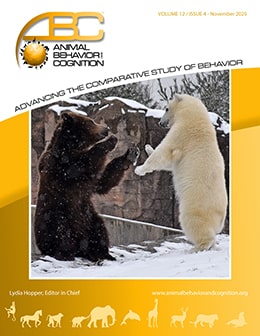Vol 12, Issue 4, November 2025
A Comparative Perspective on Attentional Bias Toward Social Threat
Citation
Reilly, O. T., & Brosnan, S. F. (2025). A comparative perspectibe on attentional bias toward social threat. Animal Behavior and Cognition, 12(4), 583-606. https://doi.org/10.26451/abc.12.04.07.2025
Abstract
For group-living species, including humans and nonhuman primates, the ability to navigate social encounters and quickly process threats from others is a critical skill. Rapid detection of threatening stimuli, referred to as an attentional bias toward threat, is adaptive in that fast threat detection can lead to improved survival outcomes. Despite this fitness benefit, the evolutionary roots of attentional bias formation are not well understood, and attentional bias toward social threat is not well studied across the primate phylogeny, particularly across more phylogenetically distant species such as the platyrrhine primates. The present review proposes the use of a comparative perspective to explore the evolutionary origins of this bias, to determine how far back in the primate phylogeny attentional bias toward social threat may have emerged. We discuss the methods that have been used to study attentional bias in humans, and then focus on a popular method for measuring attentional bias in nonhuman primates, the dot probe task. Evidence suggests that humans are not unique in their propensity for showing an attentional bias toward socially threatening stimuli when evaluated with a dot probe task, but there are some nonhuman primate species in need of further study to clarify their susceptibility to this bias. We suggest that the prevalence of attentional bias toward social threat in nonhuman primates can be understood in the context of their respective socioecologies and conclude by discussing future directions that can be taken to explore attentional bias toward social threat in other species.
Keywords
Attentional bias, Dot probe task, Nonhuman primate, Facial expression, Cortisol, Oxytocin
